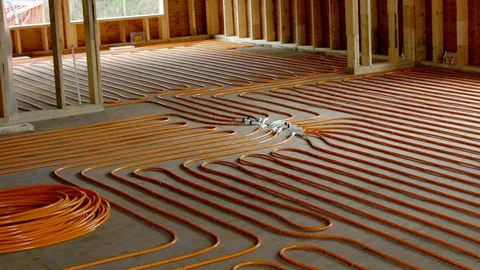As the quest for more efficient and sustainable heating solutions intensifies, radiant/infrared heat emerges as a front-runner. Its innovative approach to warming spaces offers numerous benefits over traditional heating methods, making it an attractive option for homeowners and businesses. In this blog post, we explore twelve compelling reasons why switching to Radiant Heatmight be the best decision for your comfort and energy needs.
Efficiency in Energy Usage
Radiant/infrared heat systems stand out due to their superior energy efficiency. Traditional heating methods rely on warming the air, which can lead to significant energy losses as the warm air rises and cools. In contrast, Radiant/Infrared Heat directly warms objects and people, ensuring that the energy used is effectively converted into heat. This direct transfer method means rooms reach the desired temperature quicker and maintain it with less power, resulting in lower utility bills. The efficiency of Radiant/Infrared Heat systems makes them cost-effective and aligns with the growing need for sustainable energy solutions.
Faster Heating Times
Radiant and infrared heating systems have gained popularity for their efficiency and effectiveness in providing immediate warmth. Unlike traditional heating methods that rely on warming the air, these systems directly transfer heat to objects and individuals, resulting in a more comfortable and pleasant environment.
Rapid Warmth Delivery
One of the standout features of Radiant/Infrared Heat systems is their ability to deliver warmth quickly. When you enter a room equipped with this type of heating, you can immediately feel the comforting heat envelop you without waiting for the air temperature to rise. This is especially advantageous during harsh winters or sudden temperature drops, where a quick response to changing conditions is essential for comfort.
Energy Efficiency
In addition to their rapid warming capabilities, Radiant/Infrared Heat in systems are known for their energy efficiency. By focusing on heating solid surfaces—like floors, walls, or ceilings—these systems minimise energy loss associated with air heating. This targeted approach reduces the energy required to maintain a comfortable indoor climate, resulting in lower energy bills and a reduced carbon footprint.
Ideal for Irregularly Used Spaces
Another significant benefit of Radiant/Infrared Heat is its ability to preheat irregularly used rooms quickly. For instance, spaces like guest bedrooms or home offices can be challenging to maintain at a comfortable temperature without wasting energy. With Radiant/Infrared Heat in, these areas can be warmed up in minutes, allowing you to enjoy comfort without needing constant heating.
In conclusion, radiant and infrared heating systems offer a highly effective solution for rapid warmth in various environments. Their ability to directly transfer heat to objects and people enhances comfort and contributes to energy savings. Whether in residential or commercial spaces, these systems provide a versatile and efficient heating option that caters to modern needs, making them an excellent choice for anyone looking to improve their indoor climate.
Improved Comfort Levels
Radiant/infrared heat ensures a consistent temperature throughout the room, unlike traditional forced-air systems that can create uncomfortable hot and cold zones. Directly warming objects and people avoids air stratification and uneven heating. This gentle, consistent warmth feels more natural and can significantly enhance comfort levels in living spaces.
Additionally, it eliminates the noise and drafts often associated with conventional heating methods, creating a more pleasant and serene indoor environment. Whether relaxing at home or focusing at work, the steady warmth provided by radiant/infrared heat contributes to an overall sense of well-being and comfort.
Health Benefits
Radiant/infrared heat is a healthier option for maintaining indoor air quality. Unlike traditional systems that can circulate dust and allergens, Radiant/Infrared Heat does not rely on air movement, reducing the risk of respiratory issues. Furthermore, infrared heat has been recognised for its therapeutic properties, such as improving blood circulation and alleviating muscle stiffness.
This makes it an ideal choice for individuals with health sensitivities or those seeking additional wellness benefits from their heating system. The absence of drafts also helps maintain a stable and comfortable environment free from cold spots and fluctuating temperatures.
Safety Features
Radiant/infrared heat systems are inherently safer than many traditional heating methods. Unlike space heaters or traditional radiators, these systems do not become excessively hot to the touch, significantly reducing the risk of burns or accidental fires. Additionally, many Radiant/Infrared Heat systems come equipped with automatic shut-off mechanisms and overheat protection features, ensuring they operate within safe temperature ranges.
This makes them an ideal choice for households with children or pets, providing peace of mind. The absence of exposed heating elements further minimises the risk of injuries and enhances overall safety.
Aesthetic and Space-Saving Design
Radiant/infrared heating systems are designed with aesthetics and practicality in mind. Their sleek, modern appearance allows them to integrate effortlessly into any room’s decor. These systems can be wall-mounted or installed in the ceiling, freeing up floor space and eliminating the need for bulky radiators or unsightly vents.
This minimalist design approach enhances the visual appeal of your living or working spaces and provides greater furniture arrangement flexibility. The discreet nature of radiant/infrared heating panels means they can be installed in various locations, from residential homes to commercial properties, without disrupting the existing interior design.
Environmental Impact
Radiant/infrared heat systems are a beacon of eco-friendliness in the heating industry. By consuming less energy and operating more efficiently, these systems significantly reduce overall energy consumption. Unlike traditional heating methods that often rely on fossil fuels, Radiant/Infrared Heat systems can utilise clean, renewable energy sources such as solar or wind power. This shift reduces greenhouse gas emissions and lessens the dependency on non-renewable resources.
Furthermore, the efficient nature of Radiant/Infrared Heat means fewer resources are required to achieve and maintain comfortable temperatures, further minimising environmental impact. The absence of moving parts and long-lasting durability also means fewer replacements and less waste over time.
Installation and Maintenance Costs
Installation and maintenance of radiant/infrared heat systems offer distinct advantages over traditional heating methods. The installation process is often more straightforward, involving less structural alteration and disruption. Once installed, these systems require minimal upkeep due to the lack of moving parts, which reduces the likelihood of mechanical failures and the need for frequent repairs. The longevity of radiant/infrared heating systems further translates into fewer replacements and associated costs over time.
Additionally, the simple design often means that routine checks and maintenance are easy to perform, which can be done without specialised skills or equipment. Consequently, the long-term savings in both time and money make radiant/infrared heat a financially savvy choice for homeowners and businesses.
Versatility in the Use of Radiant Heat
Radiant/infrared heat systems are highly versatile, making them suitable for various applications. These systems can seamlessly integrate into different environments, from residential homes to commercial spaces. They can be installed in living rooms, bathrooms, or even outdoor patios to provide targeted warmth exactly where needed. For commercial settings, Radiant/Infrared Heat ers are ideal for warehouses, restaurants, and office buildings, offering efficient heating solutions tailored to specific needs.
Additionally, they are perfect for areas with large open spaces or high ceilings, where traditional heating methods often need help maintaining consistent temperatures. Their adaptability also extends to supplemental heating, allowing for zone heating that focuses energy on frequently used areas, thereby enhancing overall efficiency and comfort. The flexibility of Radiant Heat systems ensures they can meet diverse heating requirements while maintaining optimal performance across different settings.
Longevity and Durability
Radiant/infrared heating systems are designed with longevity and durability in mind. These systems typically feature fewer moving parts, which means there is less potential for mechanical failure. Components such as heating panels and elements are constructed from robust materials that can withstand prolonged use and harsh conditions without degrading. This inherent durability reduces the need for frequent replacements and repairs, offering a dependable heating solution over the long term.
Additionally, the low-maintenance nature of radiant/infrared systems further extends their lifespan, as they are less prone to the wear and tear that commonly affects traditional heating systems. Sturdy construction and minimal upkeep make radiant/infrared heating a wise investment for those seeking a long-lasting and reliable heating solution.
Quiet Operation
Radiant/infrared heat operates without fans or blowers, often a noise source in traditional heating systems. This absence of mechanical sound contributes to a quieter and more serene indoor environment. The silent operation is particularly beneficial in settings where concentration and relaxation are crucial, such as offices, bedrooms, and living rooms.
By eliminating the background noise typically associated with conventional heating methods, radiant/infrared systems help create a more peaceful atmosphere. This quiet functionality is a significant advantage, especially in noise-sensitive areas or when undisturbed tranquillity is desired.
Enhanced Control and Flexibility
Modern radiant/infrared heating systems offer unparalleled control and flexibility to users. Advanced programmable thermostats enable precise temperature adjustments, ensuring that every room in your home or workplace can be individually regulated to meet specific comfort needs. Smart home integration further enhances this convenience by allowing remote control of your heating system through smartphones or voice-activated assistants. This means you can preheat your home on your way back from work or adjust the temperature of your office without leaving your desk.
Another significant advantage is the ability to implement zone heating. With radiant/infrared systems, you can selectively heat only the areas you use most frequently, avoiding the wastage of energy in unoccupied rooms. This targeted approach saves energy costs and allows for customisable comfort levels throughout different parts of a building. For example, you can keep your living room cosy while maintaining a cooler temperature in lesser-used guest rooms.
The sophisticated control mechanisms include timers, scheduling, and geofencing. Timers allow you to set your heating to turn on and off at specific times, ensuring your space is always warm when needed. Scheduling lets you create daily or weekly heating plans that align with your routine. Geofencing takes this further by using your smartphone’s location to adjust the heating system automatically as you arrive home or leave.
This enhanced level of control and flexibility not only optimises energy use but also significantly boosts comfort and convenience. With radiant/infrared heating, achieving the perfect indoor climate has never been more efficient or user-friendly, making it an ideal choice for modern living and working environments.
Conclusion
In conclusion, switching to Radiant Heat offers many benefits that enhance comfort, efficiency, and safety. From faster heating times and improved air quality to lower energy bills and reduced environmental impact, this innovative heating solution stands out as a superior alternative to traditional heating methods. With its versatility, longevity, and quiet operation, radiant/infrared heat systems provide a practical and aesthetically pleasing option for modern homes and businesses. Embracing this technology contributes to a more comfortable living or working environment and supports a sustainable future by reducing energy consumption and reliance on fossil fuels.
FAQs
1. How does Radiant Heat work?
Radiant Heat emits infrared radiation that directly warms objects and people in a room rather than heating the air. This process allows for quicker warmth and increased efficiency, as the heat is transferred directly where needed.
2. Is radiant/infrared heating safe for children and pets?
Radiant/infrared heating systems are generally safe for children and pets. They do not have exposed heating elements that can cause burns, and many systems come equipped with safety features like automatic shut-off mechanisms and overheat protection.
3. How do installation costs compare between radiant and traditional heating systems?
While radiant/infrared heating systems can have higher initial installation costs, they often require less structural alteration and disruption. Additionally, their low maintenance needs and longevity can lead to cost savings over time, making them a financially savvy choice.
4. Can radiant/infrared heat systems be integrated into existing homes?
Absolutely! Radiant/infrared heating systems can be seamlessly integrated into both new constructions and existing homes. They can be wall-mounted or installed in ceilings, providing flexibility in design and installation without significant renovations.
5. How do I maintain a radiant/infrared heating system?
Radiant/infrared heating systems require minimal maintenance due to their lack of moving parts. Routine checks for signs of wear, dusting heating panels, and ensuring proper thermostat functioning can typically be done without special skills or equipment, making upkeep straightforward.




